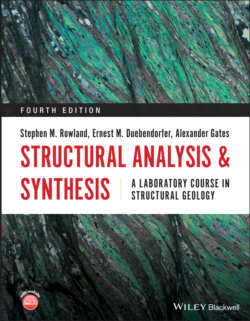Читать книгу Structural Analysis and Synthesis - Stephen M. Rowland - Страница 26
Step‐by‐Step Solution
Оглавление1 Label the three known points A, B, C and their elevations on the map.
2 Draw lines connecting the three points and making a triangle.
3 One of the lines connects the highest to the lowest of the three points. Scale this line with a ruler and find the point along it that is equal in elevation to the point of intermediate elevation. In Figure 2.10b, point B has an elevation of 160 ft, so point B′, the point on the AC line that is equal in elevation to point B, lies 6/10 of the way from point A (100 ft) to point C (200 ft).
4 Draw a line from the intermediate elevation point to equivalent scaled elevation on the highest to lowest line. This is the strike line. In Figure 2.10c, there are two points, B and B′, of equal elevation lying in the plane of the bed and defining the strike of the plane. The structure‐contour line B–B′ is drawn, and the strike is measured with a protractor to be 048 (N48°E).
5 A series of strike lines can now be drawn on the map parallel to the strike line at selected regular elevations. Use the scaled line from highest to lowest elevation to determine the structural contours to be drawn (Figure 2.10d). The spacing (d) between the structure contours of chosen elevation increments is replicated across the map to complete the structure contour map (See Figure 2.13a).
6 The spacing (d) reflects the angle of dip and the dip direction is perpendicular to strike in the direction of lower elevations. The dip angle can be determined trigonometrically like slope on a topographic map as shown for Figure 2.10 and 2.13a:
More commonly, three‐point problems are applied to well data. The procedure is the same as described for surface exposures except the elevations used in the analysis are from depth below the surface. The elevation for each well is the drilling depth subtracted from the surface elevation to yield an elevation relative to sea level, the datum. There is a difference between solid elements such as beds, faults, or dikes and the water table which is commonly independent of them. The dip angle and its direction show the direction of groundwater movement and possibly some indication of relative velocity.
Figure 2.10 Solution of a three‐point problem using a combination of graphical and trigonometric techniques. (a) Three coplanar points (A, B, and C) on a topographic map. (b) Connect by lines to make a triangle. Locate of a fourth point, B′ on the AC line, at the same elevation as point B. (c) Line B–B′ defines the strike of the plane. (d) Dip‐direction line perpendicular to the line B–B′; dip angle determined using Step 6.
